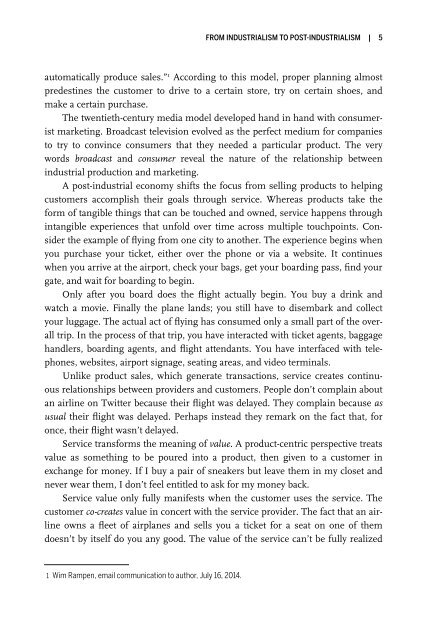Designing Delivery
1Tox6aC
1Tox6aC
Create successful ePaper yourself
Turn your PDF publications into a flip-book with our unique Google optimized e-Paper software.
FROM INDUSTRIALISM TO POST-INDUSTRIALISM | 5<br />
automatically produce sales.” 1 According to this model, proper planning almost<br />
predestines the customer to drive to a certain store, try on certain shoes, and<br />
make a certain purchase.<br />
The twentieth-century media model developed hand in hand with consumerist<br />
marketing. Broadcast television evolved as the perfect medium for companies<br />
to try to convince consumers that they needed a particular product. The very<br />
words broadcast and consumer reveal the nature of the relationship between<br />
industrial production and marketing.<br />
A post-industrial economy shifts the focus from selling products to helping<br />
customers accomplish their goals through service. Whereas products take the<br />
form of tangible things that can be touched and owned, service happens through<br />
intangible experiences that unfold over time across multiple touchpoints. Consider<br />
the example of flying from one city to another. The experience begins when<br />
you purchase your ticket, either over the phone or via a website. It continues<br />
when you arrive at the airport, check your bags, get your boarding pass, find your<br />
gate, and wait for boarding to begin.<br />
Only after you board does the flight actually begin. You buy a drink and<br />
watch a movie. Finally the plane lands; you still have to disembark and collect<br />
your luggage. The actual act of flying has consumed only a small part of the overall<br />
trip. In the process of that trip, you have interacted with ticket agents, baggage<br />
handlers, boarding agents, and flight attendants. You have interfaced with telephones,<br />
websites, airport signage, seating areas, and video terminals.<br />
Unlike product sales, which generate transactions, service creates continuous<br />
relationships between providers and customers. People don’t complain about<br />
an airline on Twitter because their flight was delayed. They complain because as<br />
usual their flight was delayed. Perhaps instead they remark on the fact that, for<br />
once, their flight wasn’t delayed.<br />
Service transforms the meaning of value. A product-centric perspective treats<br />
value as something to be poured into a product, then given to a customer in<br />
exchange for money. If I buy a pair of sneakers but leave them in my closet and<br />
never wear them, I don’t feel entitled to ask for my money back.<br />
Service value only fully manifests when the customer uses the service. The<br />
customer co-creates value in concert with the service provider. The fact that an airline<br />
owns a fleet of airplanes and sells you a ticket for a seat on one of them<br />
doesn’t by itself do you any good. The value of the service can’t be fully realized<br />
1 Wim Rampen, email communication to author, July 16, 2014.


